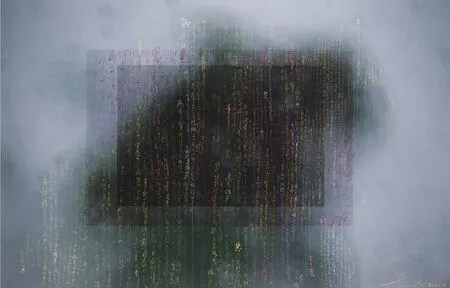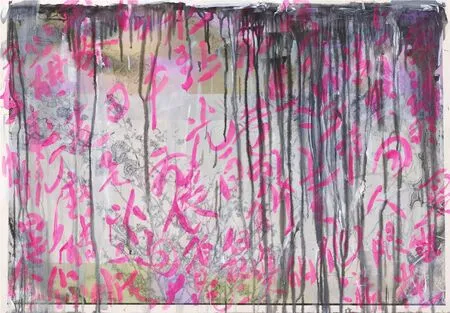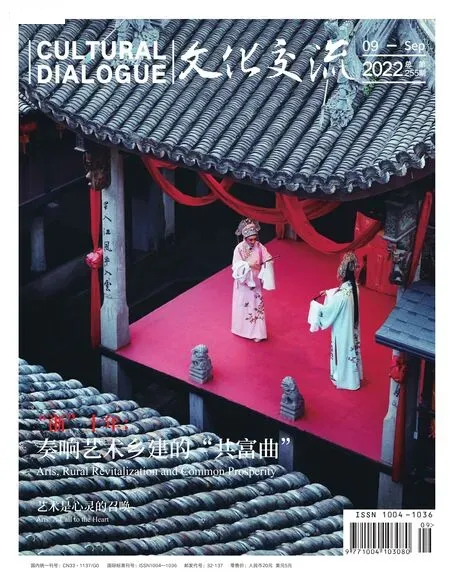七重纱的锦瑟华章
文/夏可君

储楚《璀璨的星,风中之竹》(2021年)。Bright Stars, Bamboos in Wind, a work by Chu Chu (2021).
书法在当代的书写,能够走多远?在保持笔墨的日常课作功夫后,书法又该如何接纳整个世界?答案应该是全方位的接纳与改造,从视觉本身进行重新建构。
对于如此彻底重建有着持久探索的,是浙江的佳士得特约艺术家储楚。她从小在作为雕塑艺术家的父亲的指导下学习,从设计到油画,从摄影到书法,师承书法家王冬龄先生,以最为丰富与诗意的想象力,不断地拓展书法书写的可能性,让我们看到了书法在当代的非凡之美与可容纳的开放性,并且形成了自己的独特艺术语法。
储楚的书写艺术,二十年来,以其虔诚与严谨的创作态度,从行走的风景到节令的书写,再到文化的记忆,直到都市的风景,最终都叠印在这锦瑟华章中,形成了七重纱的叠印之美,有助于我们去反思在这样一个技术时代,人性与自然是如何重建感应的。
对于储楚艺术的观看方式,首先来自日常生活,来自对自然的拍摄与观看欣赏。很多人或许都没有注意到,文字书法来自自然,只有重新回到自然,以自然为本,面对鲜活的自然景色,重新体会自然的美感,才能在慢慢地体会时光与时令的自然变化中感受到书法的独有韵味。
储楚开始拍摄自然景色,以自然景色为基底,开始书写,这是一次大胆的改造,不再仅仅是宣纸的空白,而是让空白的宣纸回到自然,宣纸本身也是来自自然草木,空白本来就是自然的敞开性与接纳性的暗示,因此,重构绘画的基底,这也是让绘画与书写同源、让自然成为重写开始的创新探索。
这是第一层底色,是书写的第一层纱,是来自自然给予的景色之美,并且付诸艺术家的摄影底本。
其次,则是一个女性对于时装与时尚的敏感。喜欢读书与摄影的储楚,经常会凝视那些贴有照片的橱窗,端详或是书店或是商店橱窗上的各种投影。日光似乎就是一个摄影师,会把室内的时尚衣装与自然植物、各种照片,连同窗外的树枝一起都重叠起来。普通人看来或许只是匆匆一瞥,但在艺术家这里,却让这样的日常叠印变成了惊鸿一瞥的作品。此叠印的视觉效果,就构成了储楚艺术的第二重纱,是把自然景色与人造景观加以重叠,增加了底本的厚度。比如她拍摄了纽约曼哈顿著名的第5 大道的时尚橱窗,借用鲍勃 · 迪伦的文字,选出一些照片,加以拼接、去色等制作方式,复制三张后再去色,每一幅都单独调整到一种微亮的效果。
这样,我们就看到了更为微妙的第三重纱,即当储楚用荧光彩色的亚克力在胶片上再次书写,就形成了文字与色彩叠加,有着明暗变化的“绘画”,这是集合了摄影、书法、上色、拼接等各种艺术手法的复合艺术,文字在可读与可视之间被呈现,空间被切割,但又具有叠印的色彩幻象。
此第三重纱已经非常复杂了,因为它综合了书法与摄影,并且强化了绘画性,书法与绘画的同源性,并非仅仅是书写行为本身,而是一种整体化视觉氛围的感知,是一种现代性的整体气氛的艺术表达。
我们继续去凝视第四重纱吧。这是颜色的叠加,尽管我们已经看到了水墨与摄影的重叠,看到了荧光色的书写,但是,就颜色而言,储楚还有着另一种对中国色的独特感知,这是把棕色隶书与金色行书叠印,把书法的文字与古老的色彩以当代叠印的方式加以组合,重构了文化历史的深度记忆,让当代的观念摄影与书写行为具有了诗意的深度。

储楚《白兰花—烟迷柳岸》。White Orchid — Misty Bank of Willows, a work by Chu Chu.
《春天十日》这个2019 年的作品,以一日一春来感怀时间的匆匆,以彩色书法与水墨树枝相互叠加,以水墨、绢本、数码打印,以叠印的影像方式形成古典和现代媒介交错的视觉感,让自然与心灵、时光与感受、诗意与制作达到了完美的合一。
最近的新作,则更为丰富。比如《四季华章 · 金色沉思》中,文字与色彩,让书写与绘画获得了另一种华丽的肌肤。
而第五重纱则来自艺术家再度进入了都市生活。毕竟现代性的生活是城市、自然与人文的共生,拥有西湖的杭州本身就是这样的一座城市。其实中国式书写,从来都不仅仅是在纸面上书写、在石碑上铭刻,乃是在天地之间书写,是以天空大地为时空,以自然烟雨为元素,在世界之中书写,是世界的书写与书写的世界,其格局从来都是无比的硕大与无机的开放,只是书法艺术容易被局限在斗方之间罢了。而储楚的书法观念接纳了大都市,她以城市为背景,借用水雾与烟雨的朦胧感为衬托,形成人为建筑与自然景色相互叠印,而书法文字,就如同无尽的细雨,仿佛是唐诗与宋词,从高处,从诗意的高空,以一种从未消失的诗意维度,缓缓落下,其诗意之美又得到了扩展和深化。
而第六重的纱则更具有概念性。储楚以代码进行创作,把科技与艺术结合,把自然景色与女性的粉色少女心融入到冰冷的数码中,开拓了文字的广度,让冰冷的代码也被赋予彩墨的生动美感,展示了书写行为的跨界开放性。
而最为美妙的第七重纱,则是储楚艺术的哲学。《璀璨的星》是体现其艺术哲学的代表系列,柳丝婀娜,莺语婉转,都被艺术家叠印在文字之间,这个系列在艺术家看来,象征着万物的发声,把象征光的书写充分给予万物,表达了情感的爱抚。
七重纱折叠的都是光,都是光影与山间的游戏褶子:这光是自然之光影,是摄影之明暗技术,是视觉之黑白,是色彩之变化,等等,一层又一层,一重又一重,都来自爱之光,对于世界之爱的凝视目光。这是心灵的目光,才可能在多重的折叠中,在世界璀璨的变幻中,在幻化的美妙中,在粉黛波影中,还保持着心神的凝定与自由的呼吸。储楚的艺术并非仅仅是对于书法的当代开拓,乃是对于中国文化与自然的深度感应,比如对于节气的反复观察,重建人性与自然的感知关联,这在一个技术虚拟时代显得尤为重要。
如此多维空间的美感,织就七重纱的奇妙编织:一重纱是烟雨诗意,一重纱是光影婆娑,一重纱是无意梦呓,一重纱是灿烂星光,一重纱是婀娜婉转,一重纱是色彩歌咏,一重纱是爱意光芒永不止息的层层涌动。
Seven-Layer Veil in Contemporary Calligraphy
By Xia Kejun

储楚《越过春天的翅膀》。Over the Wings of Spring, a work by Chu Chu.
How far can contemporary calligraphy go? How could calligraphy embrace the whole world, beyond everyday brush and ink for calligraphers? The answer should be an all-encompassing acceptance and transformation, a reconstruction from vision itself.
An artist who has a long-lasting quest for such a radical reconstruction is Chu Chu, a native of Hangzhou, Zhejiang province. As a child, she studied under the guidance of her sculptor father, from design oil painting, photography to calligraphy. She also became the disciple of calligrapher Wang Dongling, and has constantly expanded the possibilities of calligraphy and writing with the richest and most poetic imagination, showing us the extraordinary beauty and openness of calligraphy in contemporary times. On top of that, she has developed her own unique artistic vision.
Over the past 20 years, Chu’s writing art, with her devotion and rigorous creative attitude, has ranged from such subjects as walking scenes, four seasons, cultural memories, to urban landscapes. All of them overlap and complement each other like a magnificent seven-layer veil, through which we could reflect on how humanity and nature are once again connected in such a technological era.
Thefirst way to view Chu’s art is based on daily life, on the photographing and viewing of nature. It may have been neglected by many that calligraphy comes from nature. Only by going back to nature, re-experiencing its vivid beauty can we gradually savor the uniqueness of calligraphy in the changing of time.
Chu began to photograph these natural scenes as her basis for writing. It is a bold transformation, not just about the blank rice paper, but about returning the blank rice paper to nature. The rice paper itself is also made of the grass and trees, and its blankness is originally a hint of openness and receptivity of nature. Therefore,reconstructing the base for painting means the same thing for painting and writing: allowing nature as the beginning of rewriting.
This is thefirst layer: the beautiful natural landscape, which is weaved into the artist’s photographic basis.
Secondly, it is about a woman’s sensitivity to fashion and style. Chu loves reading and photography, and she often gazes at the windows with photos, or the projections on the windows of bookstores. The daylight seems to be a photographer, overlaying the indoor fashionable clothes with plants and various photos,together with the tree branches outside the window. An ordinary person may just give a quick glance at the window, yet an artist could make a stunning work out of it.
The visual effect of overlay constitutes the second layer of Chu’s art: the overlapping of natural and artificial landscapes,which adds thickness to thefilm. For example, she photographed the fashion windows of the famous 5th Avenue in Manhattan,New York, borrowing Bob Dylan’s words, selecting some photos,and, by stitching, decoloring and other techniques, giving each photo a slightly bright effect.
In this way, we see a more subtle third layer. That is, when Chu uses fluorescent colored acrylic to write again on thefilm, it forms a “painting” with superimposed words and colors, with light and dark changes. This third veil is already very complex, because it synthesizes calligraphy and photography and reinforces the features of painting.
Let us proceed to the fourth layer. Beside the overlap of ink and photography and fluorescent colors in writing, Chu has another unique perception of Chinese colors. It is the overprinting of clerical script in brown and semi-cursive script in gold, the combination of calligraphy and ancient colors in a contemporary overprint, the reconstruction of the profound memory of cultural history and the poetic depth given to conceptual photography and writing.
, a work of Chu’s created in 2019, depicts days in spring to re flect the rush of time. There is colorful calligraphy and ink-colored tree branches superimposed on each other, painted on silk scrolls and rendered by digital superimposition to form a visual sense of classical and modern art intertwined.
Her recent works are even richer, such as the words and colors in, which give writing and painting another kind of gorgeous skin.

储楚《粉黛渡影》。Pink Shadows, a work by Chu Chu.
Thefifth layer comes from the artist’s re-entry into urban life.After all, modern life is a symbiosis of city, nature and humanity;and the Chinese style of writing, in fact, is not only to write on paper or stone tablets but to write on the whole wide world. Chu’s concept of calligraphy, on the other hand, embraces metropolis culture: she uses the city as a backdrop, and borrows the haze of water mist, smoke and rain as accompaniment, forming an overlay of natural and artificial landscapes. Meanwhile the calligraphy element falls from high above like endless rain, adding an expanded poetic beauty to the whole picture.
The sixth layer is more conceptual, as Chu puts codes in her creation. By combining technology and art, she allows the lifeless codes to be endowed with the vivid beauty of colored ink,demonstrating a cross-border openness of writing.
The most wonderful seventh layer is the philosophy of Chu’s art. “Bright Star” is a representative series that embodies her artistic philosophy, with silky willows and birds warbling all superimposed between the words. This series, in the artist’s view, represents the speech of all things, which are lighted by words and caressed by emotions.
The seven-layer veil is all about light, which jumps playfully between brightness and darkness. It is the light and shadow of nature, the light and dark technique of photography, the black and white of vision, and the change of colors ... From the loving gaze at the world, they pile layer after layer peacefully and freely,regardless of radiant changes of the world.
Chu’s art is not merely a contemporary exploration of calligraphy, but a deeper sense of Chinese culture and nature,such as the repeated observation of 24 Chinese solar terms,and the reconstruction of the perceived connection between humanity and nature. This is particularly important in an era of technological virtualization.
Such multi-dimensional space fabricates its wonder into the seven-layer veil of Chu’s art: the first is about poetic, the second is about light and shadow,the third about dream, the fourth about brilliant starlight, thefifth about grace, the sixth about color,and the last is about never-ending love.

